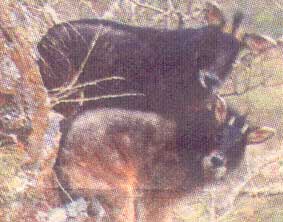(With inputs from Yasser Arafat)
Naemorhedus (=Capricornis) sumatraensis
Family: Bovidae
Group: Mammals
Status: Endangered
Serows (local- Sarauh) are the most generalized representatives of the bovid subfamily of goat antelopes called Caprinae, all of which probably evolved from a serow-like ancestor.
The mainland or Asiatic serow (Nemorhaedus sumatraensis) ranges from the Himalayas of Nepal, north to Gansu and Anhui in China, and south to the Malay Peninsula and Sumatra. Island species of serows are the Japanese serow (Nemorhaedus crispus) on Honshu, Shikoku
Island and Kyushu (Japan), and the Taiwanese serow (Nemorhaedus swinhoei) in Taiwan.
 Goat-like, the serow stands about 3.5 feet at the shoulder with a stocky body, thick neck, large head and ears, and short limbs. Its horns are stout and conical, pointed backwards, and present in both sexes. Serow are generally colored
black or reddish chestnut with white on their limbs, and they inhabit forests and wooded gorges. Usually, serow are solitary, and can be found from 6,000 feet to 10,000 feet in the Himalayan ranges in in Uttaranchal. About 50 numbers are known to exist in
Bhimtal, Uttaranchal.
Goat-like, the serow stands about 3.5 feet at the shoulder with a stocky body, thick neck, large head and ears, and short limbs. Its horns are stout and conical, pointed backwards, and present in both sexes. Serow are generally colored
black or reddish chestnut with white on their limbs, and they inhabit forests and wooded gorges. Usually, serow are solitary, and can be found from 6,000 feet to 10,000 feet in the Himalayan ranges in in Uttaranchal. About 50 numbers are known to exist in
Bhimtal, Uttaranchal.
Habitat
Where serows and their close relatives, ghorals, share habitat, serows stay mainly in dense brush above timber line. Ghorals inhabit more precipitous and barren slopes. Life span in the wild is unknown; serows live over 10 years in zoos.
Serows, like all Bovidae, are specialized herbivores called ruminants.
In the wild: Serows are predominantly browsers with selective food habits. They eat herbs, leaves of trees or shrubs, shoots, twigs and grasses.
Reproduction
Mating takes place in fall or winter. After a gestation period of 200 to 230 days, a single kid weighing about 8 pounds (3.5 kg) is born during the months of May to September. The kid will reach full size and leave the mother’s territory at 12 months and become
sexually mature by 3 years.
Life Cycle
Serows, especially males, are usually solitary but sometimes are found in pairs or family groups of up to seven. Both sexes mark territories by rubbing onto rocks and branches a secretion from their pre -orbital glands. The territory of a solitary individual
may be only three acres (1.2 ha), while that of a family group may be up to 54 acres (22 ha).
Although they are less agile and move less rapidly than ghorals, serows are sure-footed, clambering easily along well-defined trails on mountain slopes. They feed at dawn and dusk. During the heat of the day, they take shelter in favorite
resting places among rocks, in caves, under overhanging rocks or cliffs, or in dense underbrush, hidden from predators such as bears, tigers and wolves. Their smell, vision and hearing are acute.
Fascinating Facts
Serows are the most primitive living Caprinae. Their fossils appear in the late Pliocene of 7 to 2 million years ago!
Serows can be aggressive and will attempt to fight off predators, even Asian black bears, with their dagger-like horns!
Serows will swim between the small islands near the Malay Peninsula!
Once numbering as few as 2,000 to 3,000, the Japanese Government in 1955 designated the serow a "special national monument." This designation ended a long period of over hunting. Japanese serows in the wild number about 100,000 today, so are no longer considered
endangered. However, all other serow species are vulnerable or endangered due to loss of their wild habitat through logging and conversion into farmlands and plantations.
(Photograph of Serow with her eight month old calf in Bhimtal jungle-by Yasser Arafat)